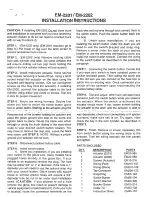
X
Refit the plugs.
X
Replace the battery compartment cover.
Charging the batteries
G
WARNING
During charging and jump-starting, explosive
gases can escape from the battery. There is
a risk of an explosion.
Particularly avoid fire, naked flames, creat-
ing sparks and smoking. Ensure there is suf-
ficient ventilation while charging and jump-
starting. Do not lean over a battery.
G
WARNING
A discharged battery can freeze at tempera-
tures below freezing point. When jump-start-
ing the vehicle or charging the battery,
gases can escape from the battery. There is
a risk of an explosion.
Allow the frozen battery to thaw out before
charging it or jump-starting.
If the warning and indicator lamps do not light
up in the instrument cluster at low tempera-
tures, it is highly probable that the discharged
battery has frozen. In this case you may nei-
ther charge the battery nor jump-start the
vehicle. The service life of a battery that has
been thawed may be shortened. The starting
characteristics may be impaired, especially at
low temperatures. Have the thawed battery
checked at a qualified specialist workshop.
!
Use a commercially-available battery
charger to charge the batteries. Make sure
that the charging voltage is correct. Do not
charge new batteries with rapid charging.
The charge current of used batteries should
be maximum 75
% of the battery capacity for
rapid charging. Otherwise, you could dam-
age the batteries.
!
The charging current must not exceed
10 % (or a maximum of 75 % for rapid charg-
ing) of the battery’s rated capacity. Other-
wise, you could damage the batteries.
If the vehicle is used often or predominantly
over short distances or is parked for a long
period, check the battery charge level more
often.
Recharge the batteries regularly if the vehicle
is parked for long periods. This ensures that
the vehicle can always be started.
A long battery service life can be achieved if
they are always adequately charged.
X
Remove the battery compartment cover.
X
Disconnect the negative terminal.
X
Disconnect the positive terminal.
Do not detach the connecting cables
between the batteries.
X
Unscrew the cell caps.
X
Set charging voltage to 24 V (see the bat-
tery charger's operating instructions).
X
Connect the battery charger to the batteries
(see the battery charger’s operating instruc-
tions).
X
Disconnect the battery charger.
X
When the batteries are recharged, screw in
the plugs.
X
Reconnect the positive terminal.
X
Reconnect the negative terminal.
X
Refit the battery cover.
Battery care
!
Dirty battery terminals and battery surfa-
ces cause creepage current. This can cause
the batteries to discharge.
!
Do not use any cleaning agents containing
fuel. Cleaning agents containing fuel cor-
rode the battery housing.
!
If dirt enters the battery cell, self-discharg-
ing of the battery is increased and the bat-
tery may be damaged.
Observe the following on battery care:
X
Always keep the terminal clamps and bat-
tery surfaces clean and dry.
X
Lightly grease the undersides of the battery
terminal clamps with acid-resistant grease.
X
Only clean the battery housing with com-
mercially available cleaning agents.
X
Only clean the batteries with the cell caps
screwed in.
Otherwise, dirt can enter the battery cells.
X
Unscrew the plugs whose vent holes are
blocked.
Maintenance
169
Maintenance and care
Z
Summary of Contents for Zetros 2020
Page 1: ...Zetros Operating Instructions Mercedes Benz...
Page 208: ...206...
Page 209: ...207...
Page 210: ...208...
Page 212: ...Order no L959 0001 02 Part no 959 584 09 82 Edition 05 20 9595840982J 9595840982...
















































